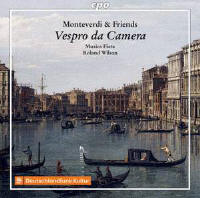Texte paru dans: / Appeared in: |
|
|
Outil de traduction |
|
|
Reviewer:
David Vickers
This all-Venetian ‘chamber vespers’ places three Monteverdi pieces within psalms, motets, sonatas and a canticle by the composer’s collegial circle at St Mark’s – his deputy Grandi, pupil Rigatti, successor Rovetta and the basilica’s instrumentalists Marini and Castello. Almost all the music was published in Venice between 1621 and 1653, the sole exception being Rovetta’s attractive fivepart Beatus vir preserved in the Düben collection at Uppsala University, but it would be unwise to assume they were composed expressly for St Mark’s. Musica Fiata’s four voices and five players assemble to conjure flexible colours and a range of sonorities from solo intimacy to enticingly fulsome textures in Rovetta’s Dixit Dominus and six-part Magnificat (both from Salmi concertati, 1626). Dominik Wörner sings with suave agility in Marini’s Domine ad adjuvandum (Salmi, 1653), a concertante conversation between bass voice, Roland Wilson’s lyrical cornett and Claudia Mende’s alert violin. Wörner is on extrovert form in Monteverdi’s solo bass setting of Laudate Dominum (printed in the posthumous Messa et salmi, 1650), which features Adrian Rovatkay’s fruity bassoon. Marie Luise Werneburg and Johannes Gaubitz duet sweetly in Monteverdi’s Confitebor tibi Domine (Messa et salmi), which scatters some daring harmonic surprises amid its melodicism. Grandi’s solo motet Exaudi me Domine (published in the anthology Ghirlanda sacra, 1625) is sung with imploring piety by Alexander Schneider, accompanied tastefully by Axel Wolf’s chitarrone. Rigatti’s soprano motet Ave regina caelorum (Salmi diversi, 1646) is sung radiantly by Werneburg, supported sympathetically by organist Arno Schneider. Three superbly played sonatas from Castello’s Libro primo (1621) are distributed evenly throughout proceedings: No 8 is a jovial conversation between Rovatkay’s bassoon and Mende’s articulate violin; Wilson joins the fray in No 9 and duets rapturously with Mende in No 3. A few vocal pieces might have benefited from the recruitment of a second violinist to play instead of cornett; a pair of violins could have interwoven more subtly with Gaubitz’s honeyed singing in Monteverdi’s Iste Confessor (Selva morale, 1641). Nevertheless, the simplicity of only four voices and continuo in Rovetta’s Litaniae della Beata Vergine (Motetti concertate, 1635) provides a touching conclusion to an imaginative programme that casts light on Monteverdi’s colleagues. |
|




